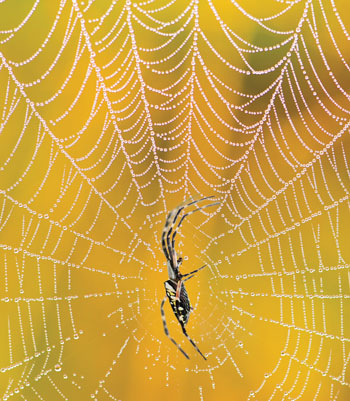Spider silk: both strong and smart

Spider silk is even stronger than Kevlar, the strongest man-made fibre.1 Combined with their glue, a special ‘smart material’,2 spiders and their silken webs are very effective at catching insects and pollen.3 And huge tarantulas shoot tiny silk strands from their feet to walk up vertical walls.4
That’s not all! The silk can also respond differently to different stresses. Markus Buehler of the Massachusetts Institute of Technology and his colleagues analyzed webs of the common European garden spider (Araneus diadematus).5,6 They found that under a light stress, such as a gentle breeze, the silk can soften and stretch. But a larger force, such as a hand accidentally brushing on it, has a different response. The strands first stretch, but then the most stretched strands suddenly stiffen then break. This sacrifice of one or a few strands keeps the damage from spreading, so the web as a whole remains intact, unlike other materials like steel. Then the spider can repair the damage when the coast is clear.
The researchers say that “superior performance of silk in webs is therefore not due merely to its exceptional ultimate strength and strain”, but that this sudden stiffening “is essential in maintaining the web’s structural integrity.” They also say, “Natural materials are renowned for exquisite designs that optimize function” including bone7 and mother-of-pearl.8
Buehler also suggests that this design concept could be applied to virtual computer networks such as the Internet. Here again, it would be useful to sacrifice a local node when under attack, to prevent the whole system from collapsing.
References and notes
- Sarfati, J., God s webspinners give chemists free lessons, Creation 23(2):20–21, 2001; creation.com/spidersilk. Return to text.
- A so-called ‘smart material’ is usually defined as a material with the ability to ‘sense and respond’ to external stimuli. Most everyday materials are not smart materials. Sarfati, J., Spiderweb stickiness secret, Creation 33(2):34–35, 2011. Return to text.
- Pollen-eating spiders, Creation 22(3):5, 2000. Return to text.
- Silk-shooting tarantulas, Creation 33(4):7, 2011. Return to text.
- Cranford, S., Tarakanova, A., Pugno, N. and Buehler, M., Nonlinear material behaviour of spider silk yields robust webs, Nature 48(7383):72–76, 2 February 2012. Return to text.
- Mann, A., Spider Silk Is Strong Because It’s Smart, Wired Science, wired.com, 1 February 2012. Return to text.
- Bone complexity: explained by function not evolution, Creation 32(4):8–9, 2010. Return to text.
- Shellfish inspire materials scientists, Creation 33(1):8, 2011. See also our book By Design, ch. 8. Return to text.


Readers’ comments
Comments are automatically closed 14 days after publication.